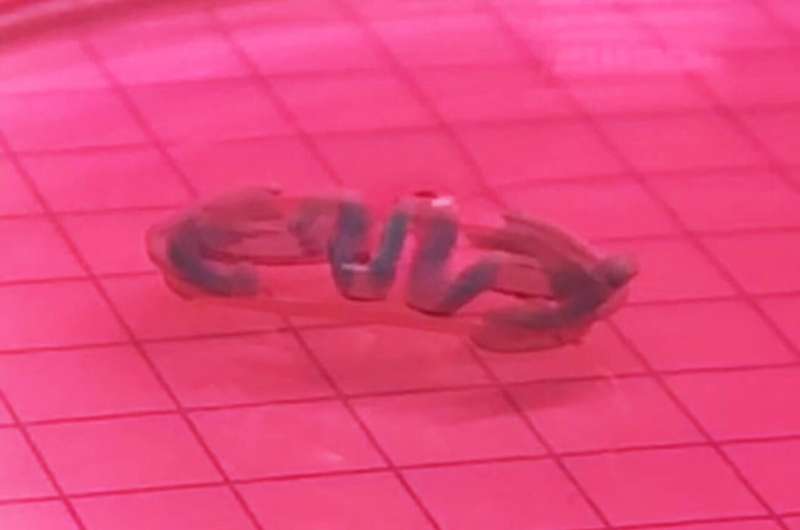
A team of researchers working at Barcelona Institute of Science and Technology has developed a skeletal-muscle-based, biohybrid soft robot that can swim faster than other skeletal-muscle-based biobots. In their paper published in the journal Science Robotics, the group describes building and testing their soft robot.
As scientists continue to improve the abilities of soft robots, they have turned to natural materials such as animal tissue. To date, most efforts in this area have involved the use of skeletal or cardiac muscles—each have their strengths and weaknesses. Skeletal-muscle-based biobots have, for example, suffered from lack of mobility and strength. In this new effort, the researchers in Spain have developed a new design for a tinyskeletal-muscle-based soft robot that overcomes both issues and is therefore able to swim faster than others of its kind.
To make their biobot, the researchers used a simulation to create a spring-based spine for a swimming creature shaped like an eel. The simulation allowed the researchers to optimize its shape. They then 3D printed the skeleton (which was made of a polymer called PDMS) and used it as a scaffold for growing skeletal muscles. The finished robot was approximately 260 micrometers long—its shape allowed for propulsion in just one direction. The biobot moves when given electrical stimulation; the charge incites the muscle to contract, which compresses the skeletal spring inside. When the stimulation is removed, the energy in the spring is released, pushing the biobot forward.
The researchers note that the biobot is able to swim in two modes: coast and burst. In coast mode, the biobot can emulate fish that coast near the bottom of a stream. In burst mode, the biobot can switch quickly from a standstill to fast movement—much quicker, the researchers claim, than any other skeletal-muscle-based biobot. Testing showed it capable of attaining speeds of up to 800 micrometers per second, which translates to approximately three body lengths per second. They note that such speeds compare with current cardiac-muscle based biobots. They suggest their design could lead to other new hybrid robots with higher force output that could be used to make swimming robots faster, or working robots stronger.

© 2021 Science X Network
Citation: Biohybrid soft robot with self-stimulating skeleton outswims other biobots (2021, April 22) retrieved 22 April 2021 from https://ift.tt/3dGxwZl
This document is subject to copyright. Apart from any fair dealing for the purpose of private study or research, no part may be reproduced without the written permission. The content is provided for information purposes only.
"soft" - Google News
April 22, 2021 at 09:45PM
https://ift.tt/3dGxwZl
Biohybrid soft robot with self-stimulating skeleton outswims other biobots - Tech Xplore
"soft" - Google News
https://ift.tt/2QZtiPM
https://ift.tt/2KTtFc8
Bagikan Berita Ini














0 Response to "Biohybrid soft robot with self-stimulating skeleton outswims other biobots - Tech Xplore"
Post a Comment